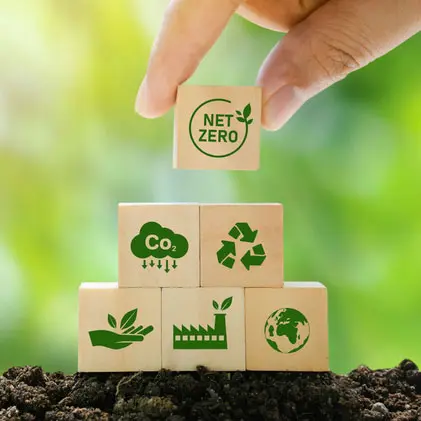By: Sarah Dobie, Ph.D., Jaela Alvarez, Sri Vedachalam, Ph.D., and Margo Davis
The Great Lakes are a critical natural resource for the United States, providing 90 percent of the nation’s water supply. With the growing frequency of flash droughts and rapid depletion of groundwater supplies across the United States, many climate practitioners are looking to the region as a future climate refuge. The region, however, can’t be a refuge for anyone unless we act now to adapt to climate change.
This was made further evident by the Fifth National Climate Assessment (NCA5), a congressionally mandated assessment of climate change and its impacts in the United States. In this blog post, we summarize key takeaways from the NCA5 for local governments and utilities to help transform the Great Lakes region into a climate refuge for current and future residents. We discuss two insights from the report and identify two priority actions for the region.
Insight #1: The Great Lakes region is already under strain from climate change
Since the first half of the 20th century, average annual temperatures have risen over 1°F across the region, with some areas rising more than 2°F. Average annual precipitation has increased between 5 to 15 percent from 1992-2021 across the region, compared to the 1901-1960 average. A recent study found that across Greater Chicago, the 10-year rainfall volume has already increased by about 30 percent during 1960-2020 and is expected to grow by another 15 percent by 2050 and 20 percent by 2100.
The region is experiencing more frequent precipitation extremes, transitioning from wet to dry and dry to wet. This means more instances of flash droughts and floods – and greater variability of Great Lakes water levels. Low water periods can limit hydropower production and shipping via coastal ports, while high water periods contribute to greater shoreline erosion, coastal habitat loss, and flooding that threaten residential properties and critical infrastructure.
Insight #2: The Great Lakes region is lagging on climate resilience action
Collectively, Great Lakes states have taken several steps to reduce greenhouse gas (GHG) emissions. Illinois, Michigan, Minnesota, and New York, have set economy-wide carbon neutrality goals for 2050. Wisconsin has committed to carbon-free electricity by 2050, and Pennsylvania has set a goal to reduce GHG emissions by 80 percent by 2050 from 2005 levels. Indiana and Ohio do not have statewide climate action plans, but have still taken action to reduce GHG emissions (see, e.g., the Indiana Department of Transportation’s Carbon Reduction Strategy, Ohio’s $3 million grant award for GHG reduction).
The NCA5’s analysis of climate action shows that Great Lakes states have lagged behind other regions in its resilience efforts – with the exception of New York state which had the second highest number of adaptation actions in the nation. That being said, there are several Great Lakes cities and utilities that are resilience leaders, such as Ann Arbor, Chicago, and Milwaukee.
What can Great Lakes cities do to prepare for climate change?
Recommendation #1: Scale up nature-based solutions to build resilience while meeting climate neutrality goals
There is a clear need for the region to accelerate its investment in climate resilience. However, the NCA5 report emphasizes that there are often trade-offs between climate mitigation and adaptation. Mitigation actions can increase climate risk, while adaptation actions can increase GHG emissions.
There is an opportunity for the region to simultaneously contribute to both goals through the scale up of nature-based solutions (NBS) across the region. There is growing recognition that NBS offer many advantages over gray infrastructure, helping to mitigate climate hazards while providing social, economic, and environmental co-benefits.
Great Lakes communities can support NBS implementation by applying for federal and state funding (e.g., Community Change Grants, Clean Water State Revolving Funds), taking advantage of technical assistance programs (e.g., Environmental Finance Centers, Community Change Grants Technical Assistance program), and joining professional networks to learn from peers (e.g., Green Infrastructure Leadership Exchange, Resilient Infrastructure for Sustainable Communities).
Recommendation #2: Use climate investments to create jobs, bolster local economic development, and drive environmental justice
The cost of implementing NBS and other climate resilient infrastructure is high. Upgrading degraded and aging infrastructure systems will cost an average of $7,547 per capita according to the NCA5’s Midwest chapter. There is the potential for a significant return on this investment by providing local benefits through job creation and local economic development – particularly for underserved communities.
This requires community-based approaches that seek to award contracts locally and to minority-, women-, and other disadvantaged businesses enterprises, as well as that include programs for talent pipeline and workforce development to increase local capacity. Examples of ways to do this include establishing performance-based contracts where governments pay for success (e.g., for gallons of stormwater captured, contracts awarded to disadvantaged business enterprises) and mentoring smaller firms to grow the local workforce.
In summary, the Great Lakes region is a leader in climate mitigation but has a ways to go in its journey toward becoming a climate refuge for its residents now and in the future. Communities can drive transformative adaptation through the scale up of NBS and by using climate investments to provide local social, economic, and environmental benefits.



